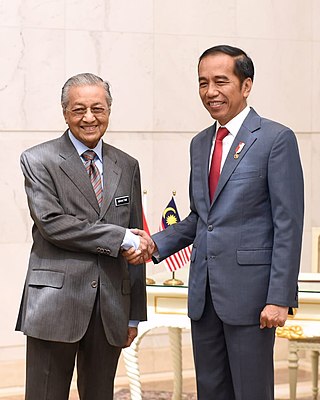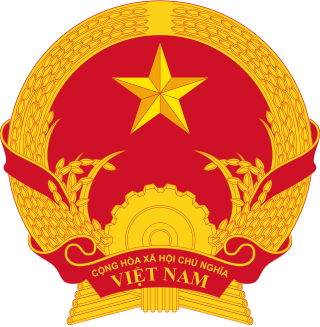
The Asian Development Bank (ADB) is a regional development bank established on 19 December 1966, which is headquartered in 6 ADB Avenue, Mandaluyong, Metro Manila 1550, Philippines. The bank also maintains 31 field offices around the world to promote social and economic development in Asia. The bank admits the members of the UN Economic and Social Commission for Asia and the Pacific, and non-regional developed countries. Starting with 31 members at its establishment, ADB now has 68 members.

Since independence, Indonesian foreign relations have adhered to a "free and active" foreign policy, seeking to play a role in regional affairs commensurate with its size and location but avoiding involvement in conflicts among major powers. During the presidency of Sukarno, Indonesia's foreign relations were marked by engagement with other newly independent nations in Asia and Africa, as exemplified by the Bandung Conference, the subsequent foundation of the Non-Aligned Movement and a confrontational attitude towards Western powers, justified by a belief in the CONEFO and opposition to what Sukarno termed as NEKOLIM.
Official development assistance (ODA) is a category used by the Development Assistance Committee (DAC) of the Organisation for Economic Co-operation and Development (OECD) to measure foreign aid. The DAC first adopted the concept in 1969. It is widely used as an indicator of international aid flow. It refers to material resources given by the governments of richer countries to promote the economic development of poorer countries and the welfare of their people. The donor government agency may disburse such resources to the government of the recipient country or through other organizations. Most ODA is in the form of grants, but some is measured as the concessional value in soft (low-interest) loans.

In international relations, aid is – from the perspective of governments – a voluntary transfer of resources from one country to another.

The New Order describes the regime of the second Indonesian President Suharto from his rise to power in 1966 until his resignation in 1998. Suharto coined the term upon his accession and used it to contrast his presidency with that of his predecessor Sukarno.
Japan has been establishing its foreign aid contributors since the 1990s. The three government institutions involved in disbursing this are: the Japan International Cooperation Agency (JICA), and the Japanese Bank of International Cooperation (JBIC). This is now the nodal agency for all Japanese concessional loans, and replaced Japan Export-Import Bank (JEXIM) and the Overseas Economic Cooperation Fund (OECF) in 1999.
Japan emerged as one of the largest foreign aid donors in the world during the 1980s.
Historically, Venezuela has been categorized as one of the most successful countries in Latin America specifically during its democratic period between 1958 and 1999. As the wealthiest country in this region and an OPEC member, Venezuela has been more frequently a donor than a recipient of foreign assistance. Its economic dependency on oil resources was the main reason why this reputation reached the international public sphere. The effectiveness of oil revenues has had a huge impact on public expenditure and, as a result, a double-sword mechanism for the government to choose between an effective role for this institution towards a welfare state and clientelism.
US$43 billion in International Monetary Fund (IMF) aid in 2003 was sent as foreign aid to Indonesia, and this assistance has traditionally been an important part of the central government's budget. From 1967 to 1991, most aid was coordinated through the Inter-Governmental Group on Indonesia (IGGI) founded and chaired by the Netherlands; since 1992, without the Netherlands, the organization has been known as the Consultative Group on Indonesia (CGI). Although Indonesia terminated its IMF aid program in December 2003, it still receives bilateral aid through the CGI, which pledged US$2.8 billion in grants and loans for 2004. Japan and the Asian Development Bank also have been key donors.

The World Bank’s assistance program of foreign aid to Vietnam has three objectives: to support Vietnam's transition to a market economy, to enhance equitable and sustainable development, and to promote good governance. From 1993 through 2004, Vietnam received pledges of US$29 billion of Official Development Assistance (ODA), of which about US$14 billion, or 49 percent, has been disbursed. In 2004 international donors pledged ODA of US$2.25 billion, of which US$1.65 billion was disbursed. Three donors accounted for 80 percent of disbursements in 2004: Japan, the World Bank, and the Asian Development Bank. During the period 2006–10, Vietnam hopes to receive US$14 billion–US$15 billion of ODA.
Nepal relies heavily on foreign aid, and donors coordinate development aid policy through the Nepal Development Forum, whose members include donor countries, international financial institutions, and inter-governmental organizations. Japan is Nepal's largest bilateral aid donor, and the World Bank and Asian Development Bank are the largest multilateral donors. Donors have been reported as losing confidence in Nepal as a result of political interference and corruption in poverty relief efforts as well as the country's apparently poor capacity to utilize aid. According to World Bank figures, official development assistance increased from US$8.2 million in 1960 to US$369 million in 2003 and then fell to US$177 million in 2004. According to Nepal's Ministry of Finance, total foreign aid committed in fiscal year (FY) 2003 was US$555 million, with 63.3 percent in grants and 36.7 percent in loans. In FY2004, total foreign aid committed was US$320 million, of which 37.7 percent was grants and 62.3 percent, loans. In June 2004, active World Bank credits totaled US$302 million, with the greatest portions allocated to the financial sector and to energy and mining. By the end of 2012, the outstanding World Bank IDA loan totaled $ 1.48 billion.

The Organisation for Economic Co-operation and Development's (OECD) Development Assistance Committee (DAC) is a forum to discuss issues surrounding aid, development and poverty reduction in developing countries. It describes itself as being the "venue and voice" of the world's major donor countries.

The Fifth Development Cabinet was the Indonesian cabinet which served under President Suharto and Vice President Sudharmono from March 1988 until March 1993. The cabinet was formed after Suharto was elected to a 5th term as president by the People's Consultative Assembly (MPR).

The Fourth Development Cabinet was the Indonesian cabinet which served under President Suharto and Vice President Umar Wirahadikusumah from March 1983 until March 1988. The cabinet was formed after Suharto was elected to a 4th term as President by the People's Consultative Assembly (MPR).
The Consultative Group on Indonesia (CGI) gathered Indonesia's international donors from 1992 to 2007 to coordinate the flow of foreign aid to Indonesia. It was set up by the Indonesian government and the World Bank.

Prof. Dr. Widjojo Nitisastro was an Indonesian economist, who was known as the main architect of the Indonesian economy during the New Order regime of President Suharto, serving as Minister for National Development (1971–1983) and Coordinating Minister for Economy, Finance and Industry (1973–1983). He was one of Indonesia's best-known and most respected economic policy-makers, both within Indonesia and overseas.

Diplomatic relations between European countries and Indonesia date back to 1949. Initially, European Union (EU)–Indonesia relations were facilitated through the EU–Association of Southeast Asian Nations (ASEAN) cooperation. Bilateral cooperation was continuously expanded and eventually the EU Delegation to Indonesia was opened in 1988. Economic and political dialogue between Indonesia and the EU takes the form of regular Senior Officials Meetings. In 2000 relations were further reinforced with the release of the European Commission's communication "Developing Closer Relations between Indonesia and the EU". In November 2013, the EU's high representative for foreign and security policy Catherine Ashton made her first official visit to Indonesia.

Johannes Baptista Sumarlin was an Indonesian economist who served as Minister of Finance. Sometimes linked with the so-called Berkeley Mafia group of economic advisers which included senior Indonesian economists such as Widjojo Nitisastro, Emil Salim, and Ali Wardhana, Sumarlin held various important economics posts in the Indonesian government for many years until the late 1990s. He graduated from the Faculty of Economics, University of Indonesia (FEUI) in 1958. Positions held in government included, among others, Chairman of the Supreme Audit Agency, Minister of Finance, Chairman of the National Planning Agency (Bappenas), and Minister for Administrative and Bureaucratic Reform.
Chinese foreign aid may be considered as both governmental (official) and private development aid and humanitarian aid originating from the People's Republic of China.

The Ministry of National Development Planning/National Development Planning Agency is a ministry of the Republic of Indonesia that has the task to oversee government affairs in the field of national development planning to assist the President in organizing state government. The minister is responsible to the President. The Ministry of National Development Planning uses organizational units and resources within the National Development Planning Agency.













